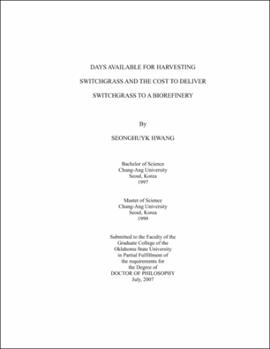| dc.contributor.advisor | Epplin, Francis M. | |
| dc.contributor.author | Hwang, Seonghuyk | |
| dc.date.accessioned | 2013-11-26T08:22:00Z | |
| dc.date.available | 2013-11-26T08:22:00Z | |
| dc.date.issued | 2007-07 | |
| dc.identifier.uri | https://hdl.handle.net/11244/6516 | |
| dc.description.abstract | Scope and Method of Study: The purpose of this study was to estimate the number of suitable field workdays per month in which switchgrass can be harvested in Oklahoma at different probability levels. This study also sought to determine the effect of the number of workdays on the cost to deliver a flow of feedstock to a biorefinery. A soil moisture balance model, drying model of cut grasses, and empirical CDF were used to determine the number of field workdays for mowing and baling operations at different probability levels. A mixed integer mathematical programming model was used to determine the optimal biorefinery location, the quantity of biomass feedstock, monthly harvest and storage quantities, optimal number of mowing and raking-baling-stacking harvest machines, and the cost to deliver feedstock to a biorefinery. | |
| dc.description.abstract | Findings and Conclusions: Harvest cost depends on the number of required harvest machines, which are constrained by the number of field workdays during the harvest window. The number of workdays for mowing and baling varies across months and regions. At the 95 percent probability level, October is the month with the least amount of time for baling switchgrass (average nine days). The southeast region of Oklahoma, which on average receives the most precipitation, has the least number of available workdays (174 mowing days and 115 baling days for a year). This information was used to determine the investment required in harvest machines to provide lignocellulosic biomass to a biorefinery. The optimal number of harvest units was 48 for mowing and 20 for raking-baling-stacking, which requires an average investment in harvest machines of 11.2 million for a 2,000 dry tons per day biorefinery. The estimated cost to deliver feedstock was 49.7 per ton and harvest cost was 17.0. Under the assumption of only three days available in each month as workdays, the estimated cost to deliver feedstock and harvest cost were 141 and 109, respectively. Ignoring or using an incorrect estimate of the number of workdays would result in incorrect feedstock cost estimates and an incorrect estimate of the investment required in harvest machinery. | |
| dc.format | application/pdf | |
| dc.language | en_US | |
| dc.rights | Copyright is held by the author who has granted the Oklahoma State University Library the non-exclusive right to share this material in its institutional repository. Contact Digital Library Services at lib-dls@okstate.edu or 405-744-9161 for the permission policy on the use, reproduction or distribution of this material. | |
| dc.title | Days available for harvesting switchgrass and the cost to deliver switchgrass to a biorefinery | |
| dc.contributor.committeeMember | Huhnke, Raymond Leroy | |
| dc.contributor.committeeMember | Chung, Chanjin | |
| dc.contributor.committeeMember | Adam, Brian Dale | |
| osu.filename | Hwang_okstate_0664D_2429 | |
| osu.accesstype | Open Access | |
| dc.type.genre | Dissertation | |
| dc.type.material | Text | |
| dc.subject.keywords | switchgrass | |
| dc.subject.keywords | biorefinery | |
| dc.subject.keywords | number of workdays | |
| dc.subject.keywords | harvesting switchgrass | |
| dc.subject.keywords | bioenergy | |
| dc.subject.keywords | delivery cost | |
| thesis.degree.discipline | Agricultural Economics | |
| thesis.degree.grantor | Oklahoma State University | |
